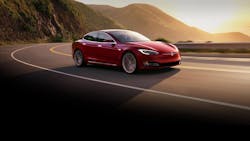Tesla to Use Radar for Braking
Sept. 12, 2016—Tesla announced Sunday that it is updating its Autopilot semiautonomous driving feature to use radar as the primary sensor used in automatic braking.
Previously, the primary sensors for the automatic braking system were cameras. Tesla avoided using radar because certain objects are not read as easily by radar as by a camera, such as people, wood or painted plastic. Additionally, some small object, such as a soda can, could reflect back to radar as much bigger, causing an unnecessary braking event.
With Tesla’s latest software update, Version 8.0, the software is able to use six times as many radar objects with the same hardware. With the additional data, the system can construct a 3D picture of the world with more frames per second to more accurately read and assess the road.
The radar can even be beamed under a vehicle in front of a Tesla to see more obstacles. The software update will also use fleet learning to determine where road signs are to avoid unnecessary braking.
